MGT723 Research Project: Green Gas Emission and Firm Disclosure
VerifiedAdded on 2023/06/12
|10
|1644
|302
Report
AI Summary
This research project investigates the relationship between green gas emissions and firm disclosure levels, applying agency theory to understand the dynamics between firms and stakeholders. The study examines the influence of carbon risk management, voluntary disclosure, and firm size on carbon emission levels. Data from 60 companies were analyzed using descriptive and inferential statistics. Key findings indicate that firms with future risk considerations and integrated climate change strategies exhibit higher disclosure scores. While disclosure scores do not directly correlate with reduced carbon emissions, they enhance a firm's positive image, attracting clients and stakeholders. The research emphasizes the importance of aligning agent-principal relationships with CDP goals to reduce carbon emissions and promote transparency, mitigating potential financial losses for shareholders. Desklib provides access to similar research projects and solved assignments for students.
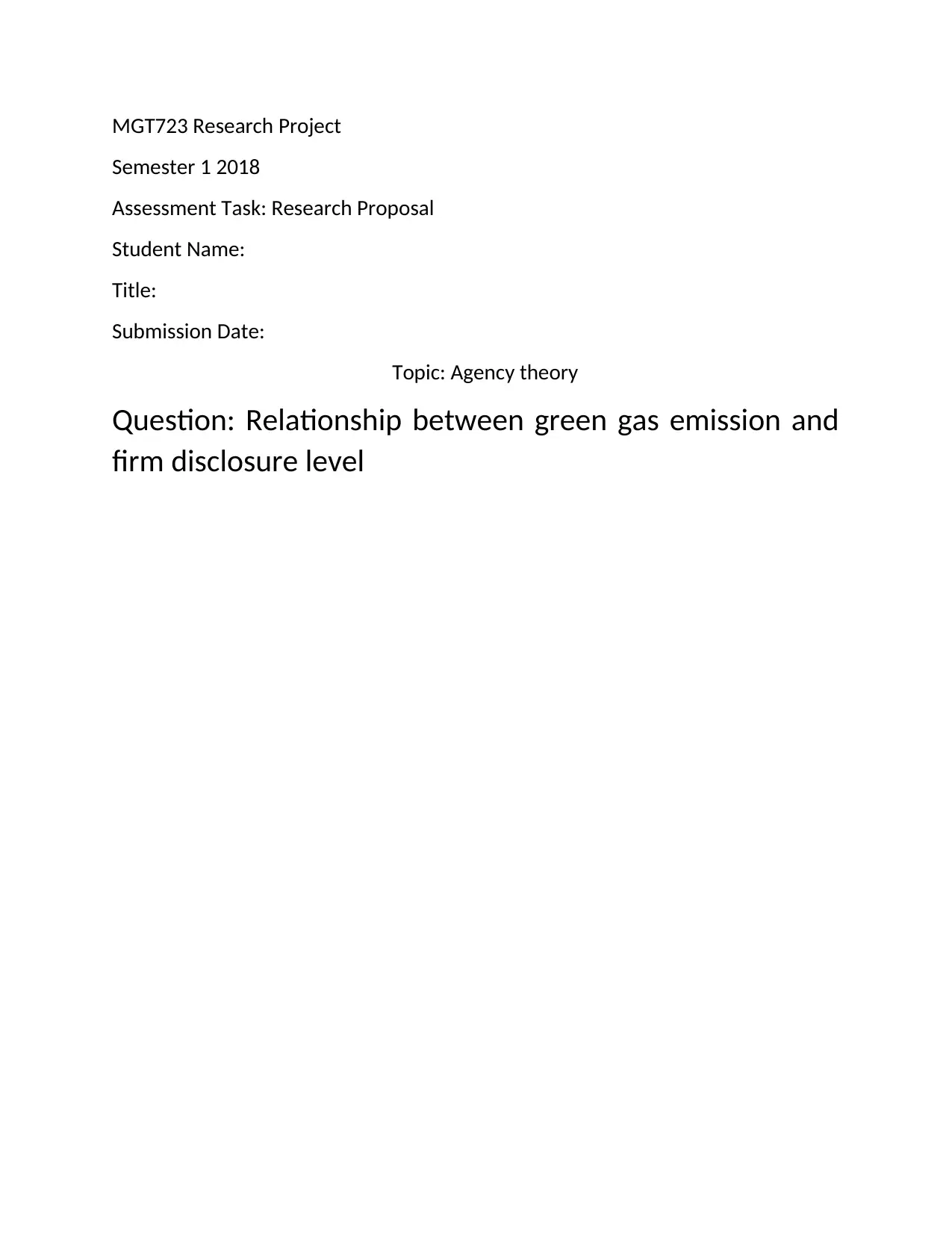
MGT723 Research Project
Semester 1 2018
Assessment Task: Research Proposal
Student Name:
Title:
Submission Date:
Topic: Agency theory
Question: Relationship between green gas emission and
firm disclosure level
Semester 1 2018
Assessment Task: Research Proposal
Student Name:
Title:
Submission Date:
Topic: Agency theory
Question: Relationship between green gas emission and
firm disclosure level
Paraphrase This Document
Need a fresh take? Get an instant paraphrase of this document with our AI Paraphraser

Acknowledgement:
I certify that I have carefully reviewed the university’s academic misconduct policy. I understand that the
source of ideas must be referenced and that quotation marks and a reference are required when
directly quoting anyone else’s words.
I certify that I have carefully reviewed the university’s academic misconduct policy. I understand that the
source of ideas must be referenced and that quotation marks and a reference are required when
directly quoting anyone else’s words.
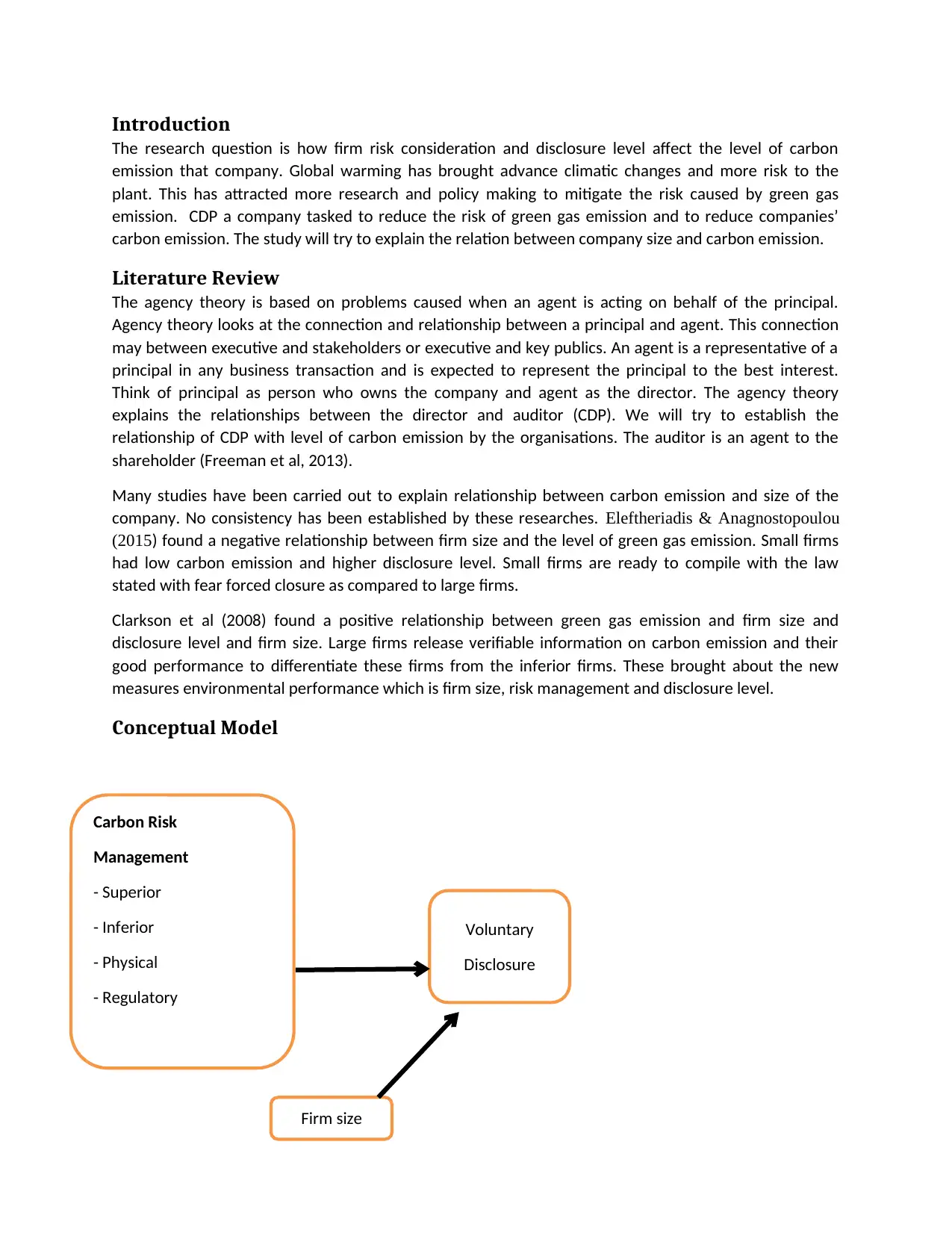
Introduction
The research question is how firm risk consideration and disclosure level affect the level of carbon
emission that company. Global warming has brought advance climatic changes and more risk to the
plant. This has attracted more research and policy making to mitigate the risk caused by green gas
emission. CDP a company tasked to reduce the risk of green gas emission and to reduce companies’
carbon emission. The study will try to explain the relation between company size and carbon emission.
Literature Review
The agency theory is based on problems caused when an agent is acting on behalf of the principal.
Agency theory looks at the connection and relationship between a principal and agent. This connection
may between executive and stakeholders or executive and key publics. An agent is a representative of a
principal in any business transaction and is expected to represent the principal to the best interest.
Think of principal as person who owns the company and agent as the director. The agency theory
explains the relationships between the director and auditor (CDP). We will try to establish the
relationship of CDP with level of carbon emission by the organisations. The auditor is an agent to the
shareholder (Freeman et al, 2013).
Many studies have been carried out to explain relationship between carbon emission and size of the
company. No consistency has been established by these researches. Eleftheriadis & Anagnostopoulou
(2015) found a negative relationship between firm size and the level of green gas emission. Small firms
had low carbon emission and higher disclosure level. Small firms are ready to compile with the law
stated with fear forced closure as compared to large firms.
Clarkson et al (2008) found a positive relationship between green gas emission and firm size and
disclosure level and firm size. Large firms release verifiable information on carbon emission and their
good performance to differentiate these firms from the inferior firms. These brought about the new
measures environmental performance which is firm size, risk management and disclosure level.
Conceptual Model
Carbon Risk
Management
- Superior
- Inferior
- Physical
- Regulatory
Voluntary
Disclosure
Firm size
The research question is how firm risk consideration and disclosure level affect the level of carbon
emission that company. Global warming has brought advance climatic changes and more risk to the
plant. This has attracted more research and policy making to mitigate the risk caused by green gas
emission. CDP a company tasked to reduce the risk of green gas emission and to reduce companies’
carbon emission. The study will try to explain the relation between company size and carbon emission.
Literature Review
The agency theory is based on problems caused when an agent is acting on behalf of the principal.
Agency theory looks at the connection and relationship between a principal and agent. This connection
may between executive and stakeholders or executive and key publics. An agent is a representative of a
principal in any business transaction and is expected to represent the principal to the best interest.
Think of principal as person who owns the company and agent as the director. The agency theory
explains the relationships between the director and auditor (CDP). We will try to establish the
relationship of CDP with level of carbon emission by the organisations. The auditor is an agent to the
shareholder (Freeman et al, 2013).
Many studies have been carried out to explain relationship between carbon emission and size of the
company. No consistency has been established by these researches. Eleftheriadis & Anagnostopoulou
(2015) found a negative relationship between firm size and the level of green gas emission. Small firms
had low carbon emission and higher disclosure level. Small firms are ready to compile with the law
stated with fear forced closure as compared to large firms.
Clarkson et al (2008) found a positive relationship between green gas emission and firm size and
disclosure level and firm size. Large firms release verifiable information on carbon emission and their
good performance to differentiate these firms from the inferior firms. These brought about the new
measures environmental performance which is firm size, risk management and disclosure level.
Conceptual Model
Carbon Risk
Management
- Superior
- Inferior
- Physical
- Regulatory
Voluntary
Disclosure
Firm size
⊘ This is a preview!⊘
Do you want full access?
Subscribe today to unlock all pages.

Trusted by 1+ million students worldwide
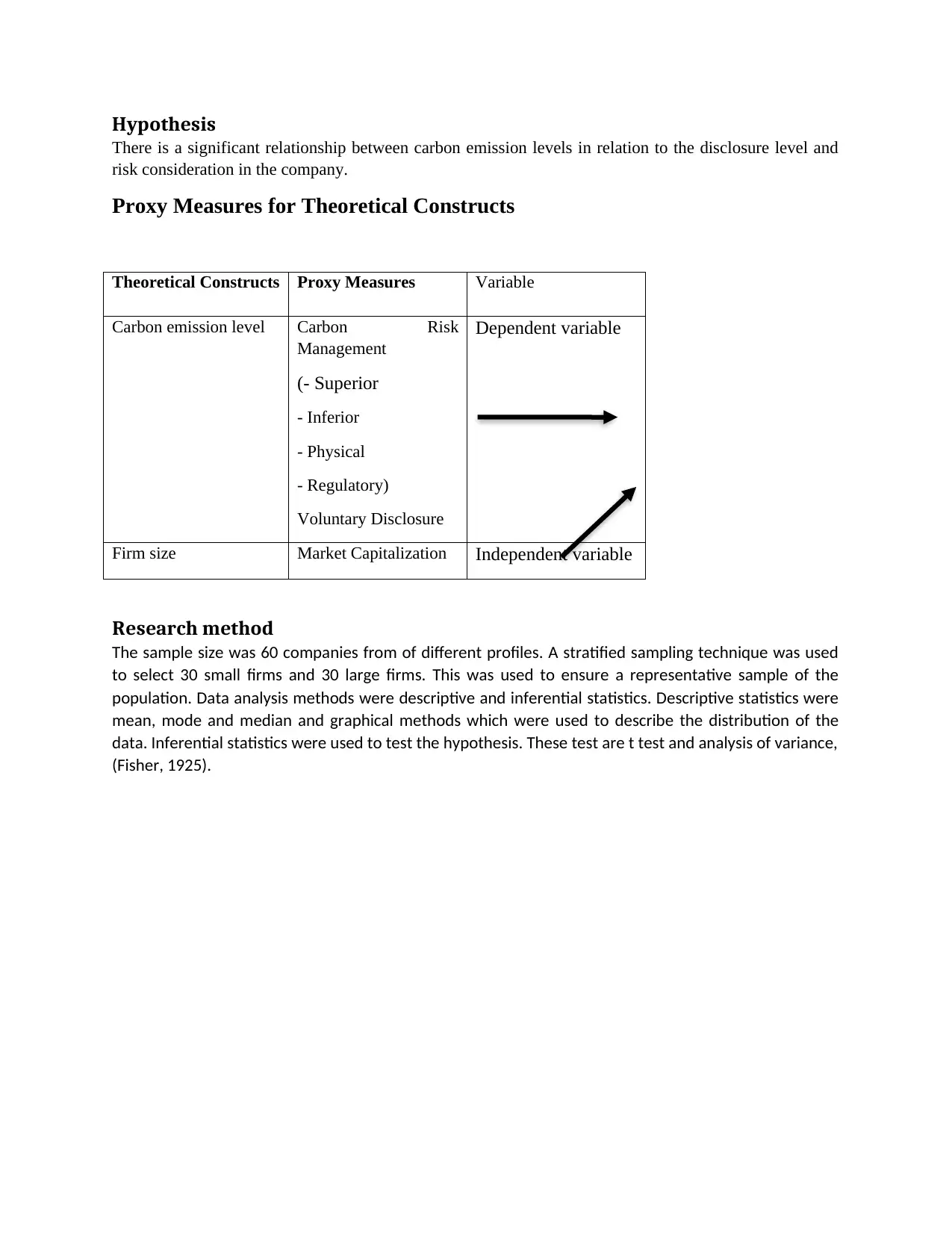
Hypothesis
There is a significant relationship between carbon emission levels in relation to the disclosure level and
risk consideration in the company.
Proxy Measures for Theoretical Constructs
Theoretical Constructs Proxy Measures Variable
Carbon emission level Carbon Risk
Management
(- Superior
- Inferior
- Physical
- Regulatory)
Voluntary Disclosure
Dependent variable
Firm size Market Capitalization Independent variable
Research method
The sample size was 60 companies from of different profiles. A stratified sampling technique was used
to select 30 small firms and 30 large firms. This was used to ensure a representative sample of the
population. Data analysis methods were descriptive and inferential statistics. Descriptive statistics were
mean, mode and median and graphical methods which were used to describe the distribution of the
data. Inferential statistics were used to test the hypothesis. These test are t test and analysis of variance,
(Fisher, 1925).
There is a significant relationship between carbon emission levels in relation to the disclosure level and
risk consideration in the company.
Proxy Measures for Theoretical Constructs
Theoretical Constructs Proxy Measures Variable
Carbon emission level Carbon Risk
Management
(- Superior
- Inferior
- Physical
- Regulatory)
Voluntary Disclosure
Dependent variable
Firm size Market Capitalization Independent variable
Research method
The sample size was 60 companies from of different profiles. A stratified sampling technique was used
to select 30 small firms and 30 large firms. This was used to ensure a representative sample of the
population. Data analysis methods were descriptive and inferential statistics. Descriptive statistics were
mean, mode and median and graphical methods which were used to describe the distribution of the
data. Inferential statistics were used to test the hypothesis. These test are t test and analysis of variance,
(Fisher, 1925).
Paraphrase This Document
Need a fresh take? Get an instant paraphrase of this document with our AI Paraphraser
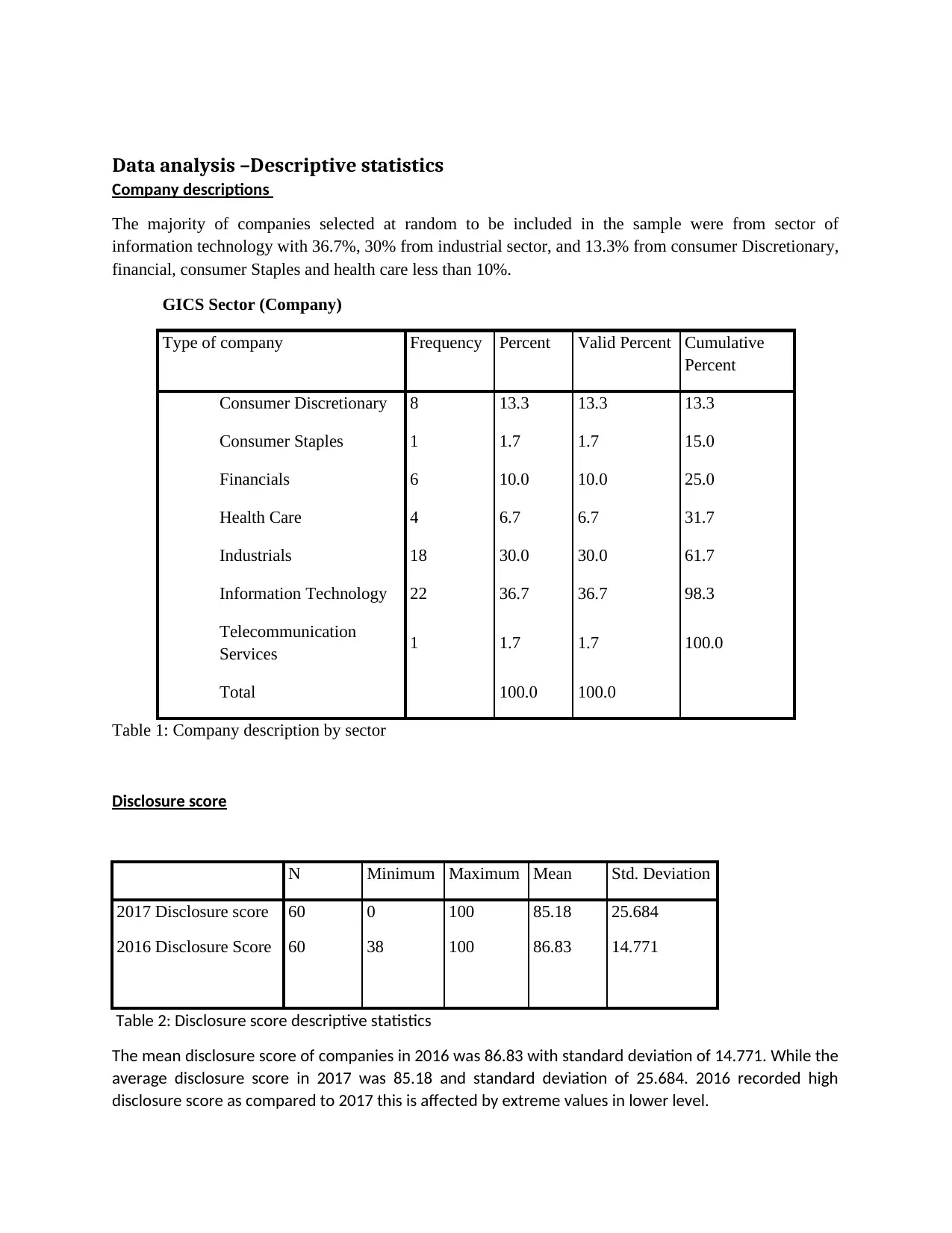
Data analysis –Descriptive statistics
Company descriptions
The majority of companies selected at random to be included in the sample were from sector of
information technology with 36.7%, 30% from industrial sector, and 13.3% from consumer Discretionary,
financial, consumer Staples and health care less than 10%.
GICS Sector (Company)
Type of company Frequency Percent Valid Percent Cumulative
Percent
Consumer Discretionary 8 13.3 13.3 13.3
Consumer Staples 1 1.7 1.7 15.0
Financials 6 10.0 10.0 25.0
Health Care 4 6.7 6.7 31.7
Industrials 18 30.0 30.0 61.7
Information Technology 22 36.7 36.7 98.3
Telecommunication
Services 1 1.7 1.7 100.0
Total 100.0 100.0
Table 1: Company description by sector
Disclosure score
N Minimum Maximum Mean Std. Deviation
2017 Disclosure score 60 0 100 85.18 25.684
2016 Disclosure Score 60 38 100 86.83 14.771
Table 2: Disclosure score descriptive statistics
The mean disclosure score of companies in 2016 was 86.83 with standard deviation of 14.771. While the
average disclosure score in 2017 was 85.18 and standard deviation of 25.684. 2016 recorded high
disclosure score as compared to 2017 this is affected by extreme values in lower level.
Company descriptions
The majority of companies selected at random to be included in the sample were from sector of
information technology with 36.7%, 30% from industrial sector, and 13.3% from consumer Discretionary,
financial, consumer Staples and health care less than 10%.
GICS Sector (Company)
Type of company Frequency Percent Valid Percent Cumulative
Percent
Consumer Discretionary 8 13.3 13.3 13.3
Consumer Staples 1 1.7 1.7 15.0
Financials 6 10.0 10.0 25.0
Health Care 4 6.7 6.7 31.7
Industrials 18 30.0 30.0 61.7
Information Technology 22 36.7 36.7 98.3
Telecommunication
Services 1 1.7 1.7 100.0
Total 100.0 100.0
Table 1: Company description by sector
Disclosure score
N Minimum Maximum Mean Std. Deviation
2017 Disclosure score 60 0 100 85.18 25.684
2016 Disclosure Score 60 38 100 86.83 14.771
Table 2: Disclosure score descriptive statistics
The mean disclosure score of companies in 2016 was 86.83 with standard deviation of 14.771. While the
average disclosure score in 2017 was 85.18 and standard deviation of 25.684. 2016 recorded high
disclosure score as compared to 2017 this is affected by extreme values in lower level.
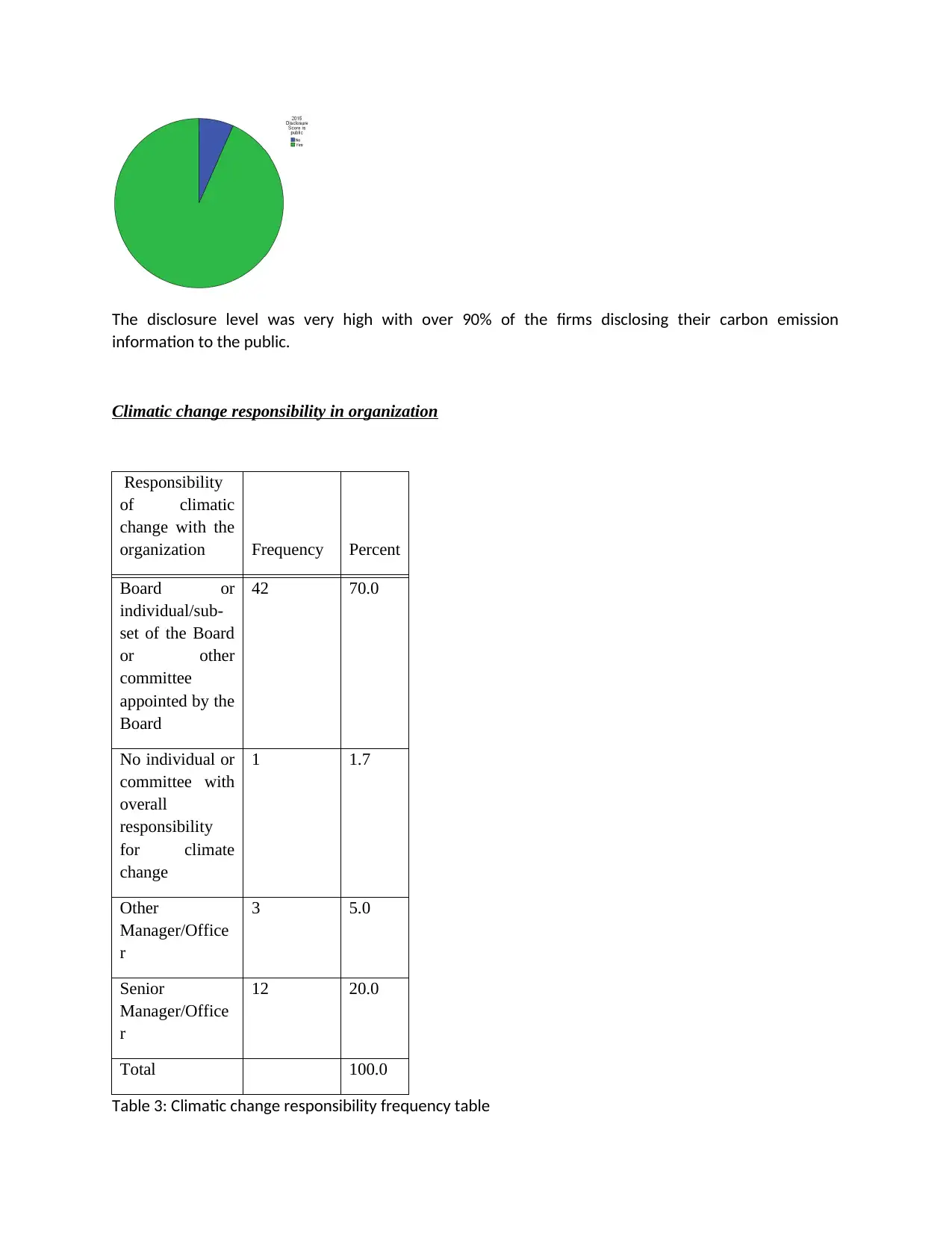
The disclosure level was very high with over 90% of the firms disclosing their carbon emission
information to the public.
Climatic change responsibility in organization
Responsibility
of climatic
change with the
organization Frequency Percent
Board or
individual/sub-
set of the Board
or other
committee
appointed by the
Board
42 70.0
No individual or
committee with
overall
responsibility
for climate
change
1 1.7
Other
Manager/Office
r
3 5.0
Senior
Manager/Office
r
12 20.0
Total 100.0
Table 3: Climatic change responsibility frequency table
information to the public.
Climatic change responsibility in organization
Responsibility
of climatic
change with the
organization Frequency Percent
Board or
individual/sub-
set of the Board
or other
committee
appointed by the
Board
42 70.0
No individual or
committee with
overall
responsibility
for climate
change
1 1.7
Other
Manager/Office
r
3 5.0
Senior
Manager/Office
r
12 20.0
Total 100.0
Table 3: Climatic change responsibility frequency table
⊘ This is a preview!⊘
Do you want full access?
Subscribe today to unlock all pages.

Trusted by 1+ million students worldwide
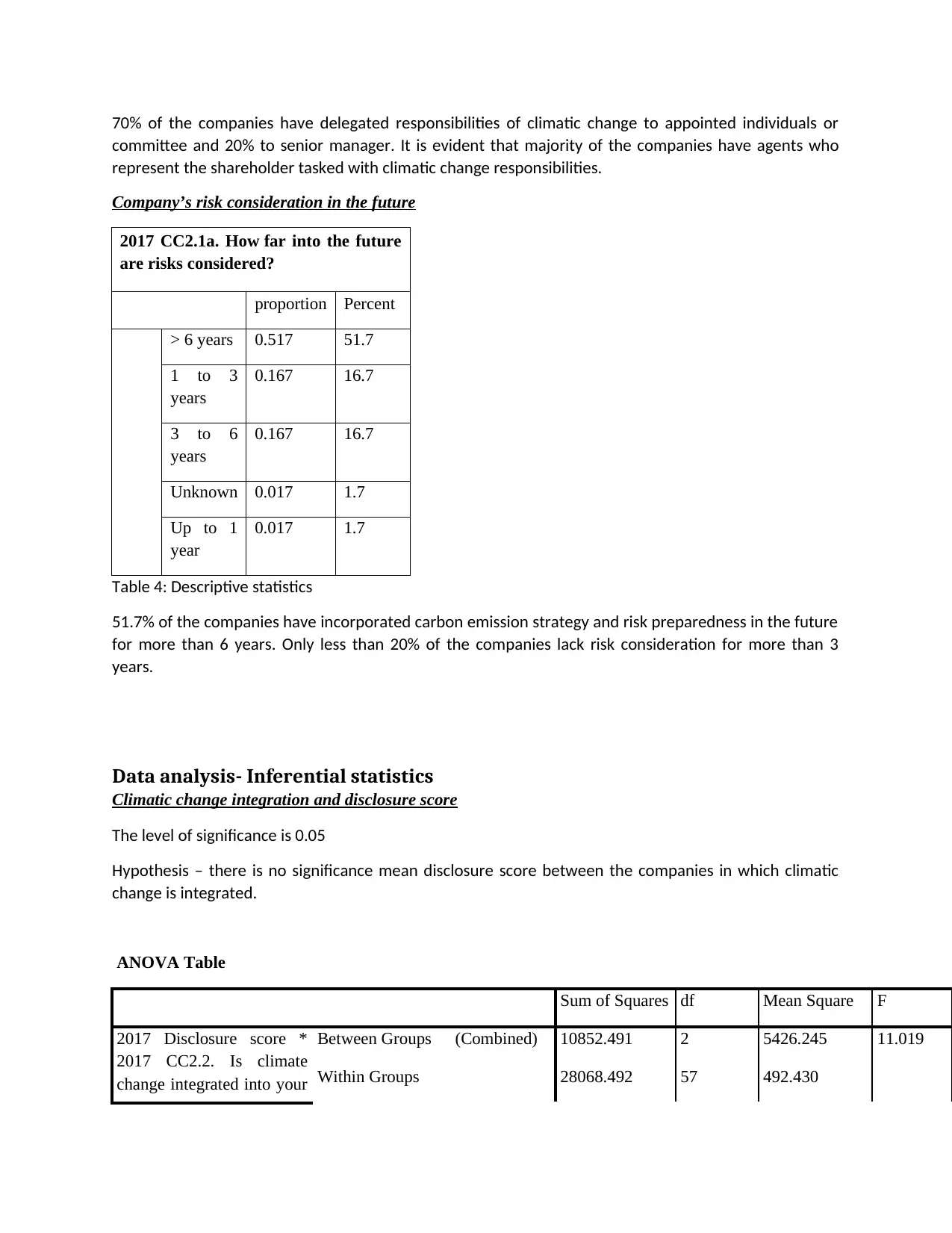
70% of the companies have delegated responsibilities of climatic change to appointed individuals or
committee and 20% to senior manager. It is evident that majority of the companies have agents who
represent the shareholder tasked with climatic change responsibilities.
Company’s risk consideration in the future
2017 CC2.1a. How far into the future
are risks considered?
proportion Percent
> 6 years 0.517 51.7
1 to 3
years
0.167 16.7
3 to 6
years
0.167 16.7
Unknown 0.017 1.7
Up to 1
year
0.017 1.7
Table 4: Descriptive statistics
51.7% of the companies have incorporated carbon emission strategy and risk preparedness in the future
for more than 6 years. Only less than 20% of the companies lack risk consideration for more than 3
years.
Data analysis- Inferential statistics
Climatic change integration and disclosure score
The level of significance is 0.05
Hypothesis – there is no significance mean disclosure score between the companies in which climatic
change is integrated.
ANOVA Table
Sum of Squares df Mean Square F
2017 Disclosure score *
2017 CC2.2. Is climate
change integrated into your
Between Groups (Combined) 10852.491 2 5426.245 11.019
Within Groups 28068.492 57 492.430
committee and 20% to senior manager. It is evident that majority of the companies have agents who
represent the shareholder tasked with climatic change responsibilities.
Company’s risk consideration in the future
2017 CC2.1a. How far into the future
are risks considered?
proportion Percent
> 6 years 0.517 51.7
1 to 3
years
0.167 16.7
3 to 6
years
0.167 16.7
Unknown 0.017 1.7
Up to 1
year
0.017 1.7
Table 4: Descriptive statistics
51.7% of the companies have incorporated carbon emission strategy and risk preparedness in the future
for more than 6 years. Only less than 20% of the companies lack risk consideration for more than 3
years.
Data analysis- Inferential statistics
Climatic change integration and disclosure score
The level of significance is 0.05
Hypothesis – there is no significance mean disclosure score between the companies in which climatic
change is integrated.
ANOVA Table
Sum of Squares df Mean Square F
2017 Disclosure score *
2017 CC2.2. Is climate
change integrated into your
Between Groups (Combined) 10852.491 2 5426.245 11.019
Within Groups 28068.492 57 492.430
Paraphrase This Document
Need a fresh take? Get an instant paraphrase of this document with our AI Paraphraser
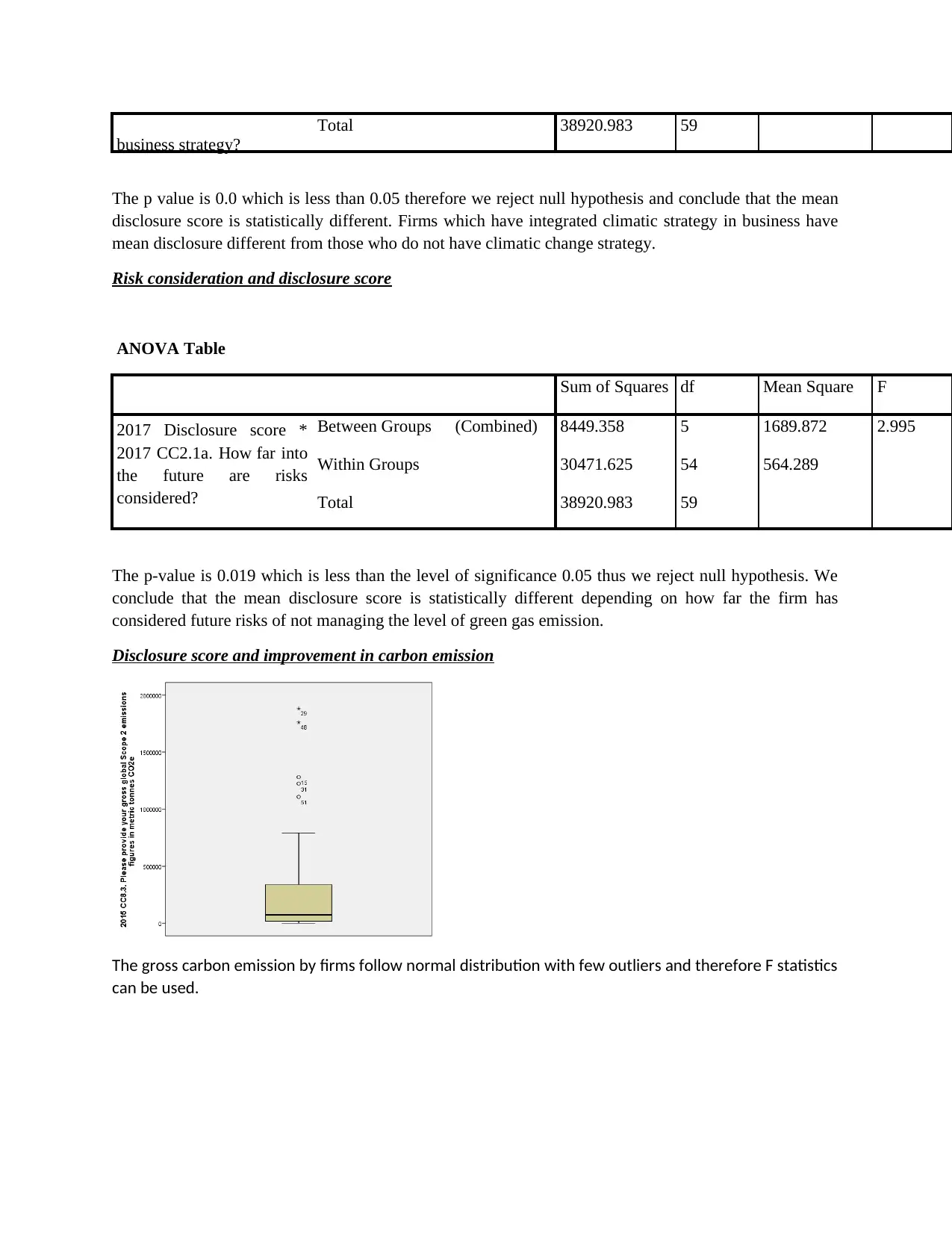
business strategy?
Total 38920.983 59
The p value is 0.0 which is less than 0.05 therefore we reject null hypothesis and conclude that the mean
disclosure score is statistically different. Firms which have integrated climatic strategy in business have
mean disclosure different from those who do not have climatic change strategy.
Risk consideration and disclosure score
ANOVA Table
Sum of Squares df Mean Square F
2017 Disclosure score *
2017 CC2.1a. How far into
the future are risks
considered?
Between Groups (Combined) 8449.358 5 1689.872 2.995
Within Groups 30471.625 54 564.289
Total 38920.983 59
The p-value is 0.019 which is less than the level of significance 0.05 thus we reject null hypothesis. We
conclude that the mean disclosure score is statistically different depending on how far the firm has
considered future risks of not managing the level of green gas emission.
Disclosure score and improvement in carbon emission
The gross carbon emission by firms follow normal distribution with few outliers and therefore F statistics
can be used.
Total 38920.983 59
The p value is 0.0 which is less than 0.05 therefore we reject null hypothesis and conclude that the mean
disclosure score is statistically different. Firms which have integrated climatic strategy in business have
mean disclosure different from those who do not have climatic change strategy.
Risk consideration and disclosure score
ANOVA Table
Sum of Squares df Mean Square F
2017 Disclosure score *
2017 CC2.1a. How far into
the future are risks
considered?
Between Groups (Combined) 8449.358 5 1689.872 2.995
Within Groups 30471.625 54 564.289
Total 38920.983 59
The p-value is 0.019 which is less than the level of significance 0.05 thus we reject null hypothesis. We
conclude that the mean disclosure score is statistically different depending on how far the firm has
considered future risks of not managing the level of green gas emission.
Disclosure score and improvement in carbon emission
The gross carbon emission by firms follow normal distribution with few outliers and therefore F statistics
can be used.
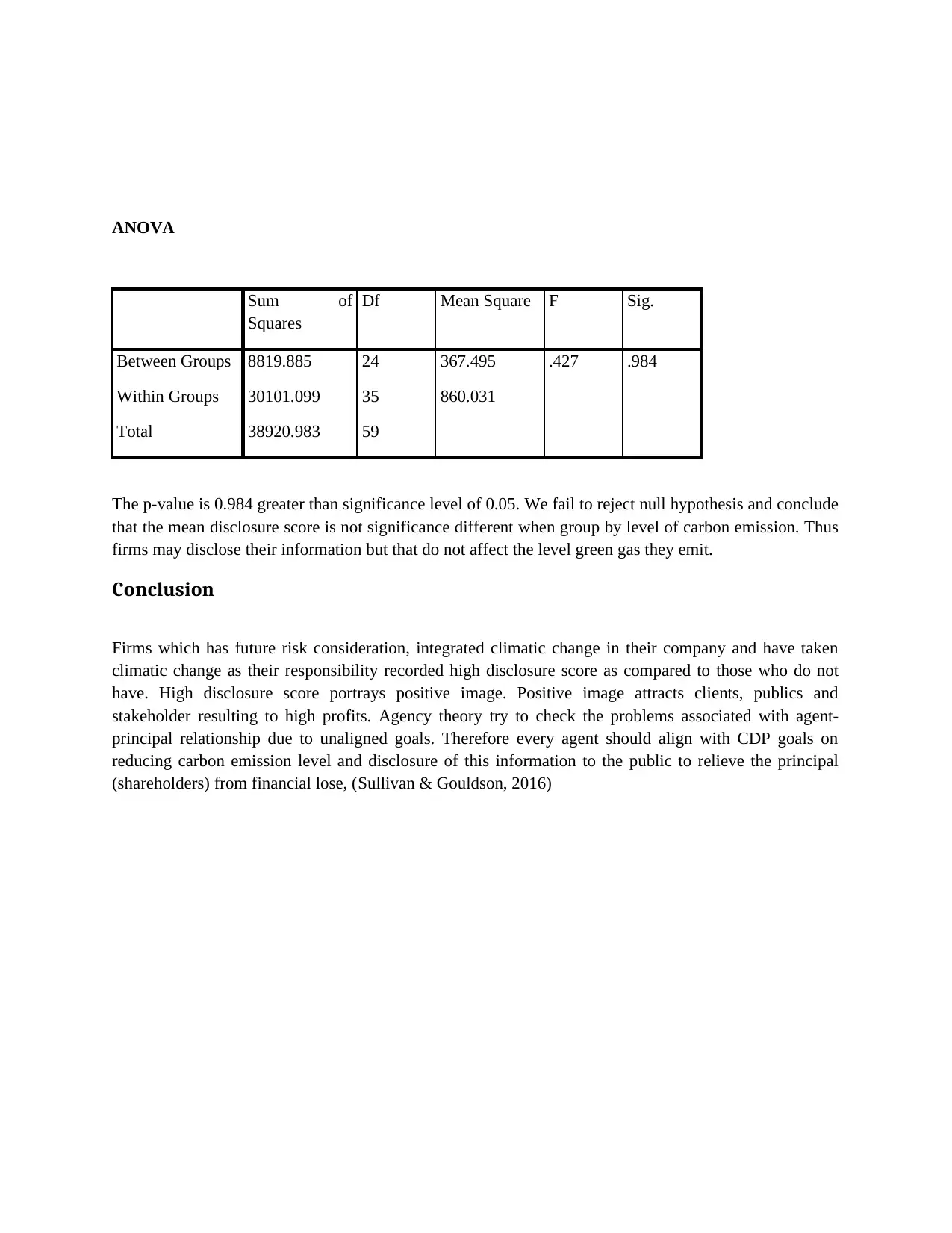
ANOVA
Sum of
Squares
Df Mean Square F Sig.
Between Groups 8819.885 24 367.495 .427 .984
Within Groups 30101.099 35 860.031
Total 38920.983 59
The p-value is 0.984 greater than significance level of 0.05. We fail to reject null hypothesis and conclude
that the mean disclosure score is not significance different when group by level of carbon emission. Thus
firms may disclose their information but that do not affect the level green gas they emit.
Conclusion
Firms which has future risk consideration, integrated climatic change in their company and have taken
climatic change as their responsibility recorded high disclosure score as compared to those who do not
have. High disclosure score portrays positive image. Positive image attracts clients, publics and
stakeholder resulting to high profits. Agency theory try to check the problems associated with agent-
principal relationship due to unaligned goals. Therefore every agent should align with CDP goals on
reducing carbon emission level and disclosure of this information to the public to relieve the principal
(shareholders) from financial lose, (Sullivan & Gouldson, 2016)
Sum of
Squares
Df Mean Square F Sig.
Between Groups 8819.885 24 367.495 .427 .984
Within Groups 30101.099 35 860.031
Total 38920.983 59
The p-value is 0.984 greater than significance level of 0.05. We fail to reject null hypothesis and conclude
that the mean disclosure score is not significance different when group by level of carbon emission. Thus
firms may disclose their information but that do not affect the level green gas they emit.
Conclusion
Firms which has future risk consideration, integrated climatic change in their company and have taken
climatic change as their responsibility recorded high disclosure score as compared to those who do not
have. High disclosure score portrays positive image. Positive image attracts clients, publics and
stakeholder resulting to high profits. Agency theory try to check the problems associated with agent-
principal relationship due to unaligned goals. Therefore every agent should align with CDP goals on
reducing carbon emission level and disclosure of this information to the public to relieve the principal
(shareholders) from financial lose, (Sullivan & Gouldson, 2016)
⊘ This is a preview!⊘
Do you want full access?
Subscribe today to unlock all pages.

Trusted by 1+ million students worldwide

References
Clarkson P., Li, Y., Richardson G., & Vasvari F., 2008. 'Revisiting the relation between environmental
performance and environmental disclosure: an empirical analysis', Accounting, Organization and Society,
33:4-5, pp. 303-27.
Eleftheriadis M. & Anagnostopoulou G. 2015, "Relationship between Corporate Climate Change
Disclosures and Firm Factors", Business Strategy and the Environment, 24(8), pp. 780-789.
Fisher R.A. 1925. Methods For Research Work; Macmillan Publishers: London.
Freeman R., Edward E., Moutchnik M., & Alexande A. 2013. "Stakeholder management and CSR:
questions and answers.". UmweltWirtschaftsForum. 21 (1), pp. 5–9.
Sullivan R. & Gouldson A. 2016. "Comparing the Climate Change Actions, Targets and Performance of
UK and US Retailers", Corporate Social Responsibility and Environmental Management, 23(3), pp. 129-
139.
Clarkson P., Li, Y., Richardson G., & Vasvari F., 2008. 'Revisiting the relation between environmental
performance and environmental disclosure: an empirical analysis', Accounting, Organization and Society,
33:4-5, pp. 303-27.
Eleftheriadis M. & Anagnostopoulou G. 2015, "Relationship between Corporate Climate Change
Disclosures and Firm Factors", Business Strategy and the Environment, 24(8), pp. 780-789.
Fisher R.A. 1925. Methods For Research Work; Macmillan Publishers: London.
Freeman R., Edward E., Moutchnik M., & Alexande A. 2013. "Stakeholder management and CSR:
questions and answers.". UmweltWirtschaftsForum. 21 (1), pp. 5–9.
Sullivan R. & Gouldson A. 2016. "Comparing the Climate Change Actions, Targets and Performance of
UK and US Retailers", Corporate Social Responsibility and Environmental Management, 23(3), pp. 129-
139.
1 out of 10
Related Documents
Your All-in-One AI-Powered Toolkit for Academic Success.
+13062052269
info@desklib.com
Available 24*7 on WhatsApp / Email
![[object Object]](/_next/static/media/star-bottom.7253800d.svg)
Unlock your academic potential
© 2024 | Zucol Services PVT LTD | All rights reserved.





